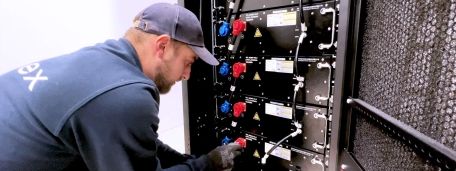
Nokia has chosen cablex as its partner for the technical installations and commissioning at the Swisscom locations. cablex has already implemented various nationwide rollout projects for Nokia successfully in the past.
The NEWTON project.
The current optical transport platform of Swisscom has been in use for several years now and has been upgraded regularly with updates. Altogether, the system is in use at more than 900 Swisscom and 5000 customer locations. These locations, which are connected to each other with optical fibre cables over a length of around 100,000 kilometres, are used to transport high volumes of data. Every transport platform does have a limited service life, however. What's more, the daily demand for additional bandwidth is increasing rapidly and the necessary capacity must be provided. These are the main factors that influenced the decision to replace the existing optical platform of Swisscom.
What is an optical transport platform?
An optical (photonic) network transmits information using light and not electrical currents/signals. Data signals run over long distances and high capacity links between data centres. These so-called "backbones" use light pulses to transmit data, which can then be converted into electrical signals by network devices as required.

The technology in detail.
A distinction is made between Backbone Offices (BBO) and Metro Core Offices (MCO). The backbone is basically the highway of the network. Local lines are connected to these central lines and feed in their data. Due to the high transmission capacity that is required, backbones are implemented with optical fibre lines. The Metro Core lines, over which data is also transmitted optically using light, act as "side roads." The backbone is of course designed with multiple redundancy options, and traffic can be redirected in different ways.
On long optical fibre links, the light becomes weaker as the distance increases. For this reason, the backbones in smaller Swisscom exchanges are strengthened with so-called inline amplifiers (ILA).
The task package.
Plans are in place to upgrade 20 backbone sites and two data centre locations in 2021. About 600 locations will be added by the time the project is completed at the end of 2023. From today's perspective, the overall project will involve more than 30,000 hours of work for the cablex team.
At cablex, between four and ten employees have been working on the project this year since mid-June. The amount of work required depends on the components available at the different locations. cablex technicians from different regions and areas are used, and cooperation within the team works really well.

The components required for the installation vary depending on the model used. In the first phase, the 20 backbone sites and the two data centres will be created and put into operation. These will be connected to power and optical fibre networks and together form the backbone of the optical transport platform. After the locations and sites are configured, Nokia will pass them on to Swisscom.

The supply of materials.
All materials (hardware) for the respective installation orders are handled and stored temporarily by Nokia Solutions and Networks Schweiz AG via its logistics partner PostLogistics in Mägenwil. Once the material has been requested, it is sent sent directly to the Swisscom exchange locations in the regions where it is available immediately for our technicians to install.

The rollout is running according to plan. Construction and integration of the backbone stations will be completed by mid-December 2021. Within the scope of installation work, we can demonstrate our flexibility on a daily basis. Due to Corona and general market-related bottlenecks, delays in the delivery of the required materials are experienced time and again. As a result, our technicians often plan additional ways to complete the installation work professionally and on time.
This was also confirmed by Norbert Moser, project manager at Nokia Solutions and Networks Schweiz AG:
"We already started our cooperation with cablex as part of the installation of the proof-of-concept system in the fourth quarter of 2020. This cooperation has been running since June 2021 as part of the implementation of the backbones. The work includes the provision of the infrastructure and commissioning of the corresponding network elements. The target for 2021 is the realisation of 20 backbone sites and the associated amplifier sites by the end of the year. The Metro rollout for approximately 600 locations will begin in January 2022.
With cablex, we have a competent partner at our side who supports us professionally and actively. The high level of commitment and motivation of the cablex employees involved must also be mentioned, as they ensure the jointly defined rollout targets can be achieved. The cooperation within the partnership is very much appreciated by Nokia."














